FUNCTION TRANSFORMATION
Let's start this by knowing what function is....
*A Function is a relation between a set of inputs and a set of permissible outputs with the property that each input is related to exactly one output.
means that...
" In each value of x, there is only one value of y"
sample??..
IN f(x) = x2
*note: f(x) = y
IF x = 2, THEN y = 4
IF x = 3, THEN y = 9
IF x = 4, THEN y = 16 ...and so on...
If we graph it, it should look like this...
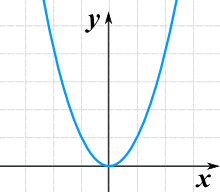
f(x) = x2
NOW THAT'S A FUNCTION...
*SO IS A CIRCLE A FUNCTION??..
...well its
HOW TO KNOW IF A GRAPH IS A FUNCTION??.. :D
Well there's a TEST to know if a GRAPH is a FUNCTION....
ITS V. L. T OR VERTICAL LINE TEST.. :D
If we draw a vertical line in a circle, the line INTERSECTS TWICE. So it means, its NOT a function.
NOTE: If the vertical line intersects the graph only once, the graph is a FUNCTION.
NOW THAT WE KNOW WHAT FUNCTION IS.
*Can we move or resize the graph of a function?..YES!!..
Let us start with a function, in this case it is f(x) = x2, but it could be anything:

f(x) = x2
Here are some simple things you can do to move or scale it on the graph:
You can move it up or down by adding a constant to the y-value:
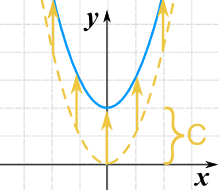
g(x) = x2 + C
Note: if you want to move the line down, just use a negative value for C.
- C > 0 moves it up
- C < 0 moves it down
You can move it left or right by adding a constant to the x-value:
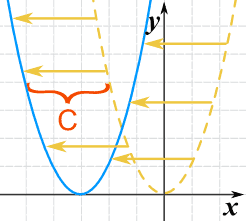
g(x) = (x+C)2
Adding C moves the function to the left (the negative direction).
Why? Well imagine you are going to inherit a fortune when your age=25. If you change that to(age+4) = 25 then you would get it when you are 21. Adding 4 made it happen earlier.
- C > 0 moves it left
- C < 0 moves it right
An easy way to remember what happens to the graph when you add a constant:
add to y: go high
add to x: go left
add to x: go left
BUT you must add C wherever x appears in the function (you are substituting x+C for x).
Example: the function v(x) = x3 - x2 + 4x
Move C spaces to the left: w(x) = (x+C)3 - (x+C)2 + 4(x+C)
You can stretch or compress it in the y-direction by multiplying the whole function by a constant.
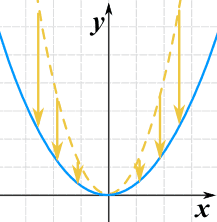
g(x) = 0.35(x2)
- C > 1 stretches it
- 0 < C < 1 compresses it
You can stretch or compress it in the x-direction by multiplying x (wherever it appears) by a constant.
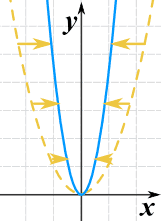
g(x) = (2x)2
- C > 1 compresses it
- 0 < C < 1 stretches it
Note that (unlike for the y-direction), bigger values cause more compression.
You can flip it upside down by multiplying the whole function by -1:
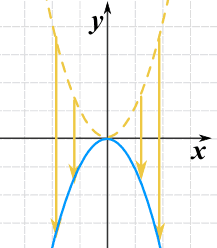
g(x) = -(x2)
This is also called reflection about the x-axis (the axis where y=0)
You can combine a negative value with a scaling.
Example: multiplying by -2 will flip it upside down AND stretch it in the y-direction.
You can flip it left-right by multiplying the x-value by -1:
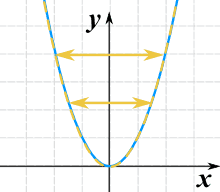
g(x) = (-x)2
It really does flip it left and right! But you can't see it, because x2 is symmetrical about the y-axis. So here is another example using √(x):
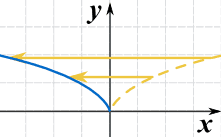
g(x) = √(-x)
This is also called reflection about the y-axis (the axis where x=0)
Summary
| y = f(x) + C |
|
| y = f(x + C) |
|
| y = C·f(x) |
|
| y = f(Cx) |
|
| y = -f(x) |
|
| y = f(-x) |
|
All In One ... !
You can do all transformation in one go using this:

- |a| > 1 stretches
- |a| < 1 compresses
- a < 0 flips the graph upside down
- |b| > 1 compresses
- |b| < 1 stretches
- b < 0 flips the graph left-right
- c < 0 shifts to the right
- c > 0 shifts to the left
- d > 0 shifts upward
- d < 0 shifts downward
Thats it...
Sources:
GOOGLE :D
http://www.mathsisfun.com/sets/function-transformations.html
No comments:
Post a Comment